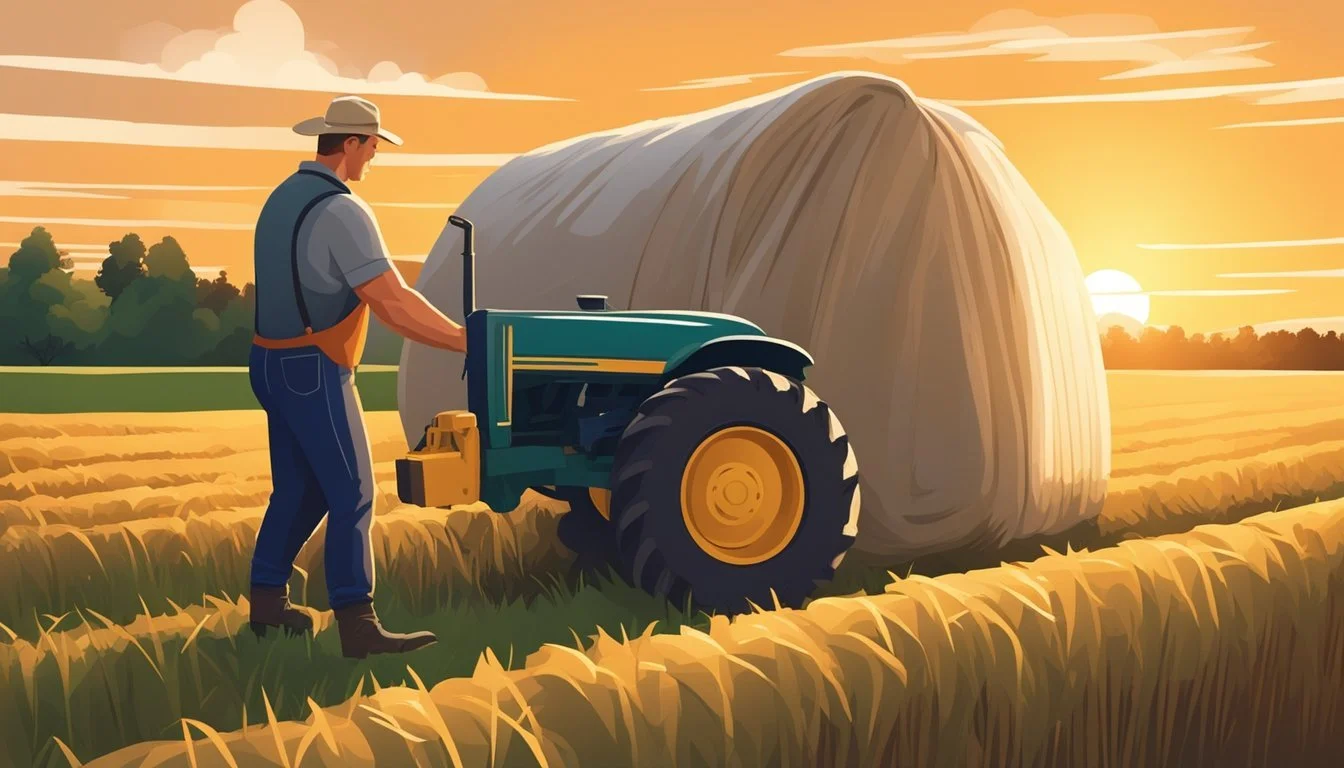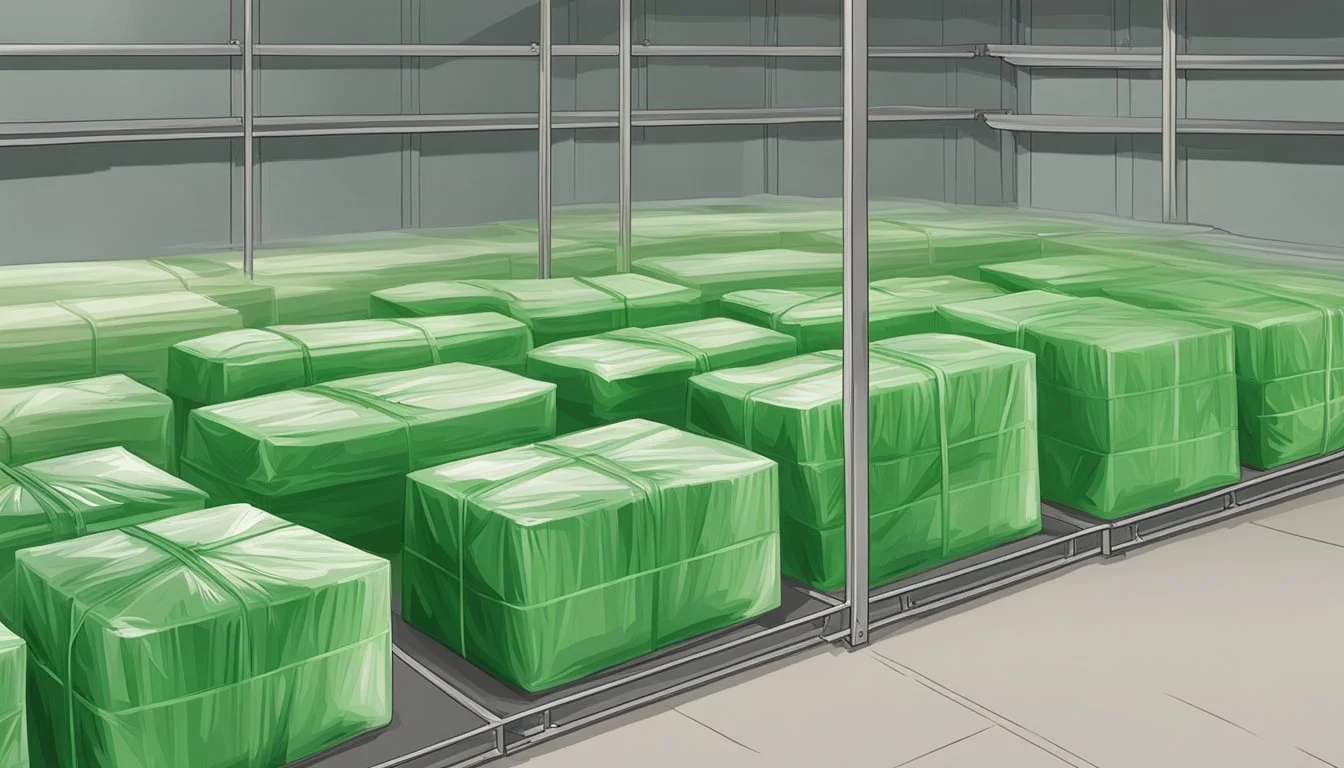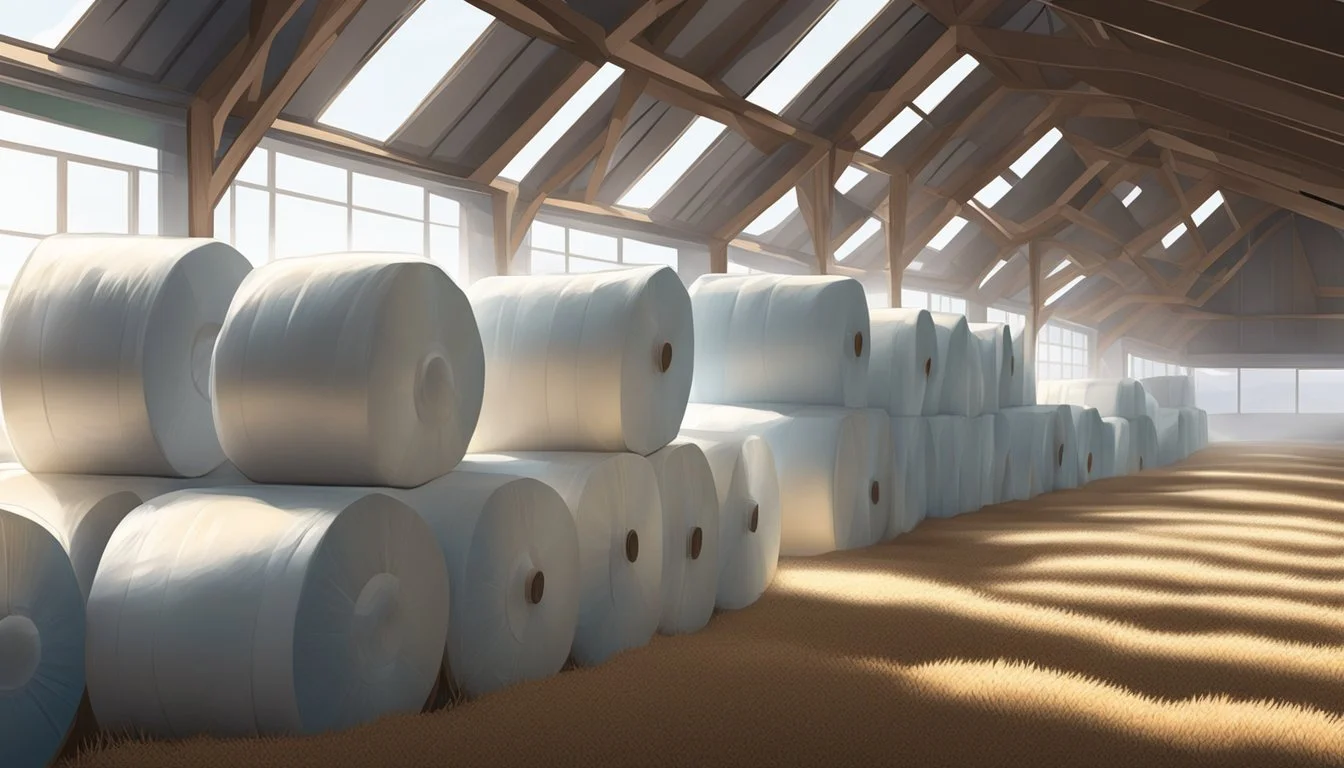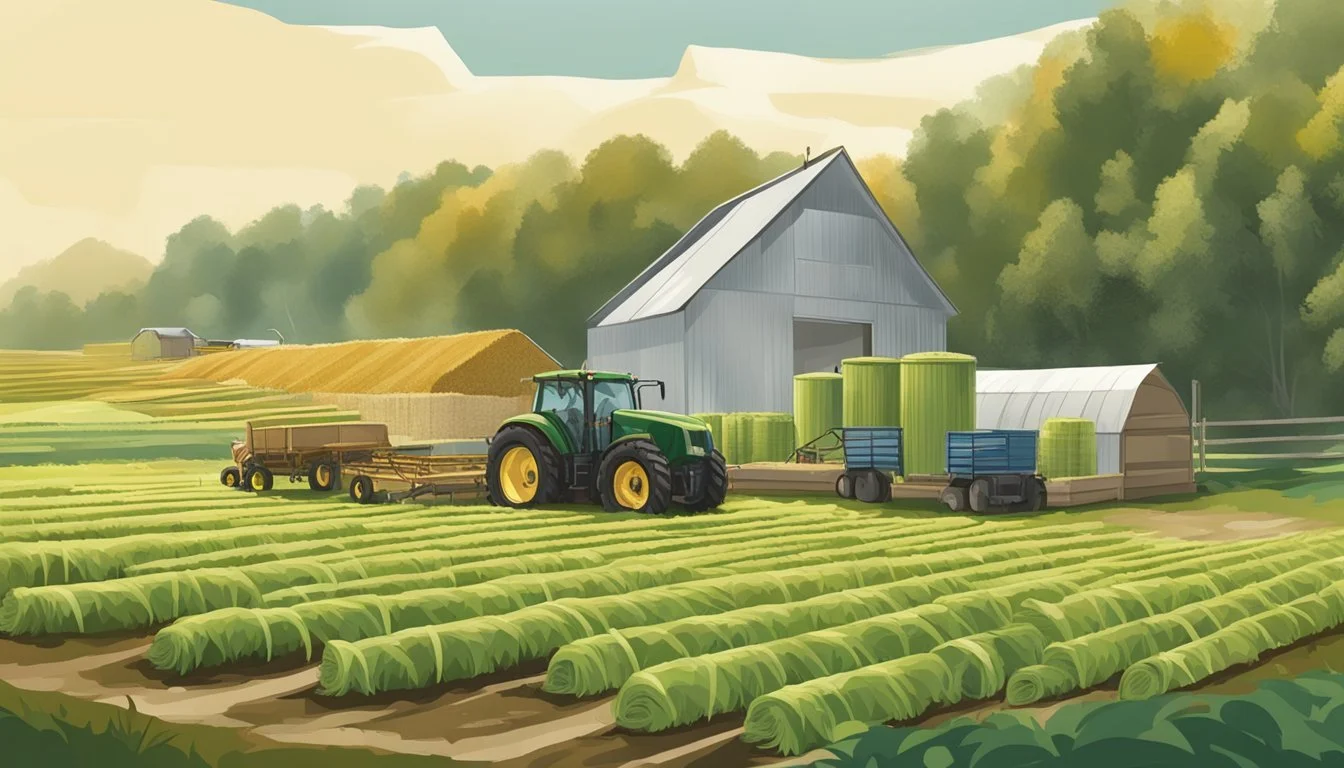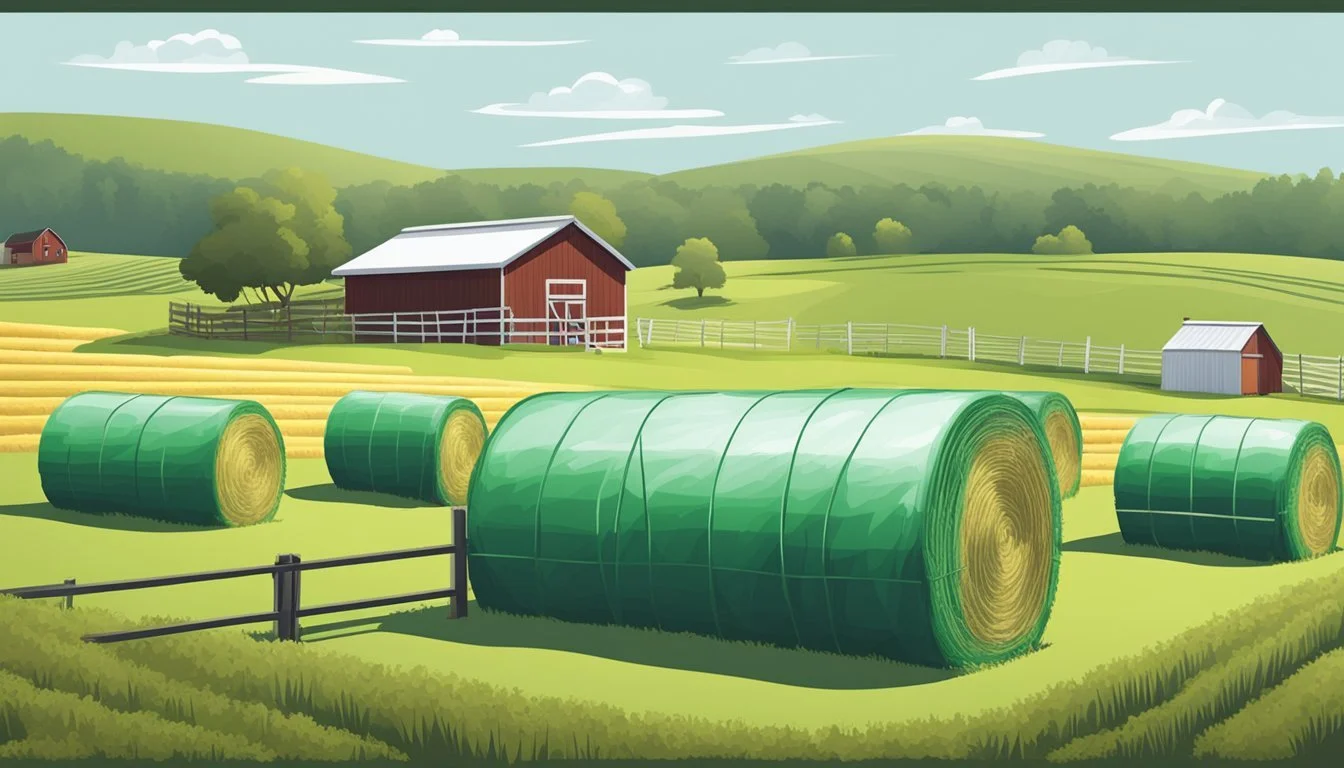The Ultimate Guide to Silage Wrap
Mastering Airtight Forage Preservation for Homesteaders
Preserving forage through silage is a cornerstone practice in homesteading that ensures a stable and nutritious feed supply for livestock during times when fresh pasture is not available. Silage wrap is a specialized material used to maintain the quality of forage by creating an airtight seal around baled crops. This practice encapsulates fodder within a protective barrier, shielding it from oxygen and the elements, which is crucial in the silage-making process. The absence of oxygen inside the wrapped bales is essential as it facilitates the anaerobic fermentation that preserves the forage, enhancing its longevity and nutritional value.
The effectiveness of silage as a preservation method relies heavily on the correct application of silage wrap. It is imperative to apply the film tightly and evenly to form an effective seal. Too loose, and the risk of spoilage escalates; too tight, and there's a threat of the film tearing. Appropriate layering of the film, generally recommended to be a minimum of six layers, plays a vital role in ensuring durability against potential damage and maintaining the desired anaerobic environment. Moreover, monitoring the wrapped bales regularly for any tears or air pockets is an ongoing necessity to prevent spoilage.
Storing wrapped bales in the right conditions further guarantees the quality of the preserved forage. An ideal storage space is cool, dry, and shielded from direct sunlight and pests, to enhance the longevity of the silage and protect its nutritional content. Homesteaders who execute these steps carefully can achieve success in maintaining a year-round supply of high-quality forage, integral for the health and productivity of their livestock.
Understanding Silage
Silage plays a pivotal role in livestock nutrition by preserving forage in a state that retains its nutritional content. Through an anaerobic fermentation process, silage provides a reliable feed source that can be stored for extended periods.
Basics of Forage Preservation
Silage is the result of forage preservation through controlled fermentation in airtight conditions. This method significantly reduces the loss of nutritional value due to the prevention of air and moisture ingress, which can lead to spoilage. The anaerobic environment, created by proper wrapping and sealing, promotes beneficial bacterial growth which ferments the forage, thereby preserving its quality.
The Role of Silage in Livestock Feeding
Silage is a staple in livestock feed, providing a high-energy, nutrient-rich diet throughout the year, even when fresh forage is not available. Its preservation maintains the nutritional content required for the health and productivity of livestock. The airtight seal prevents the growth of harmful bacteria and mold, ensuring that the feed remains safe and nutritious for animal consumption.
Comparing Silage Types: Hay, Straw, and Corn
When considering forage types, there are notable differences:
Hay: Produced by drying grasses or legumes until they contain a low moisture content, hay is stored in bales without fermentation.
Straw: The dry stalk of cereal plants left after the grain is harvested, straw is used primarily for bedding rather than as a nutrient-rich feed.
Corn Silage: Made by fermenting the entire corn plant, corn silage is an energy-dense forage that supports milk production and growth in cattle, thanks to its high carbohydrate content.
Each of these serves different purposes in livestock nutrition and farm management. Silage, with its preservation qualities and high nutritional value, often becomes the primary feed for ruminants, especially during times when fresh forage is scarce.
Silage Wrap Functionality
The effectiveness of silage wrap is critical in maintaining the quality of forage for livestock. It provides an airtight seal that preserves nutritional value, offers protection from environmental factors, and supports the fermentation process necessary for silage production.
Characteristics of Effective Silage Wrap
Effective silage wrap must exhibit several characteristics critical to its performance. The wrap is typically made from polyethylene, a plastic film known for its strength and durability. These attributes are essential to withstand the mechanical stress during the wrapping process and post-wrap handling. An ideal silage film should have the following qualities:
Puncture and tear resistance: To maintain integrity during application and storage.
Elasticity: To ensure a snug fit that conforms to the shape of the bale.
Thickness consistency: Even distribution of plastic across the film minimizes weak spots.
Oxygen Barrier Properties
Oxygen barrier is another vital feature of silage wrap. The presence of oxygen can significantly hinder the preservation process by promoting the growth of aerobic bacteria and mold which spoil the forage. A high-quality silage wrap has a low oxygen transmission rate, which preserves the feed's nutritional quality by:
Inhibiting aerobic spoilage: Oxygen barrier prevents aerobic organisms from proliferating.
Enhancing anaerobic fermentation: The absence of oxygen supports the fermentation process needed to stabilize the forage.
UV Resistance and its Importance
UV resistance in silage wrap is crucial to protect the silage from the harmful effects of the sun's rays. It helps in extending the life of the silage film and therefore the protection of the baled forage. The importance of UV resistance is twofold:
Preservation of film integrity: Prolonged exposure to sunlight can degrade plastic films, but UV-resistant silage wrap remains effective over time.
Protection of nutritional content: UV-resistant properties ensure that the forage maintains its quality by preventing the degradation of vital nutrients.
Application and Use
In third-person perspective, this section focuses on the utilization of silage wrap, emphasizing proper techniques to apply the wrap, manage its storage, and handle the material. It also lays out the essential equipment for wrapping bales, providing a structured guide for both round and square bales to ensure optimal forage preservation.
Best Practices in Silage Wrap Application
To achieve an airtight seal on round and square bales, one must adhere to strict application methods. The process begins by wrapping the bale tightly and evenly. It is crucial to:
Maintain minimum overlap of 50% while wrapping.
Apply at least six layers of silage wrap for robust protection against air and moisture.
Regularly inspect the wrapped bales for damage, and reseal any compromised areas promptly.
Efficient Handling and Storage
To retain the quality of the silage and extend its shelf life, proper handling and storage are paramount. Once wrapped, bales should be:
Stored in a cool, dry location, away from direct sunlight to prevent degradation of the wrap and forage inside.
Positioned in a way that minimizes the risk of damage from equipment or pests.
Kept on a clean, dry surface to prevent the bottom layers from becoming punctured or spoiled.
Equipment Used for Wrapping Bales
The effectiveness of silage wrap application largely depends on the equipment used. For homesteaders, it is advised to utilize:
A reliable bale wrapper, compatible with both round and square bales, which can consistently apply the wrap with the required tension and overlap.
Wrappers should have features such as adjustable speed settings and automatic cut-off for the wrap to streamline the process.
Preservation and Storage
The integrity of silage as a high-quality feedstock hinges on meticulous preservation and storage practices, ensuring forage retains its nutritional value through an airtight environment and controlled fermentation.
Creating an Airtight Seal
The establishment of an airtight seal is paramount to preserving silage. Specialized silage stretch wrap film is employed to wrap the bales, forming a barrier that clings snugly and eliminates the entry of air. It's crucial to meticulously wrap each bale to prevent oxygen from reaching the forage, which can foster the growth of detrimental bacteria and molds.
Key Actions:
Thoroughly wrap bales with silage film.
Inspect for any punctures or tears post-wrapping.
Optimizing Storage Conditions
Silage storage conditions directly affect forage quality. It is essential to protect the wrapped bales from environmental elements such as rain or sun. Additionally, selecting an appropriate location that is dry with minimal temperature fluctuations will help maintain the integrity of the silage.
Considerations for Storage:
Place wrapped bales on a flat, well-drained surface.
Avoid areas prone to flooding or excessive sunlight.
Regularly monitor bales for damage or spoilage.
Anaerobic Fermentation Process
Under airtight conditions, anaerobic fermentation commences, turning stored carbohydrates into acids. This process stabilizes the silage, making it more palatable and digestible for livestock. Properly executed, it minimizes nutrient loss and inhibits mycotoxin formation, as air is unable to infiltrate the feed.
Fermentation Guidelines:
Ensure bales are tightly sealed to promote anaerobic conditions.
Monitor silage pH levels to track fermentation stages.
Mitigating Risks
To achieve the best results in silage preservation, one must actively mitigate risks related to spoilage, pest invasions, and environmental challenges. This section outlines how to navigate these risks to ensure the integrity of the silage is maintained throughout storage.
Preventing Spoilage and Losses
Observing proper moisture content when preparing silage is vital; it should be compacted to reduce air pockets which could lead to spoilage. At least six layers of silage wrap are recommended, as this provides an effective barrier against oxygen, thereby preventing the growth of harmful bacteria and molds that can cause spoilage. Regular inspections for tears or weak spots in the film can catch early signs of damage that, if unchecked, could result in significant losses.
Key Practices:
Ensure correct moisture content and compaction to minimize air pockets.
Apply multiple layers of wrap to seal out oxygen.
Conduct regular inspections for film integrity.
Protection Against Pests and Environmental Factors
Ensuring the wrapped bales are stored away from direct sunlight and potential pests like rodents and insects, such as ants, is crucial. A well-applied wrap acts as a protective shield, deterring pests from penetrating and compromising the quality of the forage. Pests not only damage the wrap but can introduce contamination, leading to spoilage.
Storage Guidelines:
Store bales in cool, dry places.
Keep away from direct sunlight to prevent UV damage to the film.
Establish barriers or traps to mitigate pest threats.
Weather Damage and Moisture Control
The impact of weather elements on silage quality cannot be overemphasized. The silage needs to be stored in areas less prone to flooding or standing water to prevent moisture from undermining the airtight seal. Additionally, proper overlap during wrapping can ensure that the bales are more resistant to weather-related damage, and thus, moisture entry.
Weatherproofing Tips:
Select storage areas with good drainage.
Overlap wrapping film by a minimum of 50% to enhance durability and protection.
Use quality wrap capable of withstanding weather extremes.
Quality and Performance
Selecting the right silage wrap directly impacts the preservation of forage. It is essential that the wrap exhibits superior quality, appropriate thickness, puncture and tear resistance, and lasting durability to maintain the nutritional value of the silage.
Evaluating Silage Wrap Thickness and Quality
Thickness is a critical determinant of a silage wrap's quality and performance. Silage wraps generally range in thickness from 25 to 150 micrometers. A thicker film often equates to better oxygen barrier properties, which is pivotal in preserving the silage's nutritional value. Quality wraps should provide consistent thickness throughout, contributing to uniform protection.
Resistance to Punctures and Tears
A quality silage wrap must exhibit high puncture resistance and resistance to tears. This ensures that the wrap can withstand the rigors of wrapping operations and exposure to on-farm conditions without being compromised. Strong puncture resistance minimizes the risk of air entering the bale, which is critical to maintain an anaerobic environment necessary for proper fermentation.
Assessing Longevity and Durability
Longevity and durability are measures of how well a silage wrap withstands environmental exposure over time. Premium silage wraps often include UV protection to sustain their integrity against sunlight exposure. Durability is not just about surviving the elements, but also about maintaining the strength necessary to keep the bale sealed until feedout. High-quality wraps should not degrade or weaken significantly during the storage period.
Environmental Considerations
When considering silage wrap from an environmental perspective, one must account for the material's life cycle impact on the ecosystem. The focus is on providing sustainable solutions that align with responsible farming practices.
Biodegradable and Recyclable Options
Farmers have the option to choose biodegradable silage wraps that break down naturally over time, reducing the environmental footprint. These wraps are usually made from plant-based materials like polylactic acid (PLA) which, under proper conditions, decompose back into the soil. On the other hand, recyclable silage wraps, typically made of polyethylene, can be repurposed after use, diverting waste from landfills and conserving resources.
Reducing Waste in Silage Wrap Usage
To minimize environmental impact, farmers must proactively seek ways to reduce waste.
Efficient Use: Applying the correct amount of wrap can avoid overuse, which conserves material.
Proper Recycling Practices: Clean and sort used wraps for recycling to ensure they are accepted by recycling facilities.
Reuse where Appropriate: Where hygiene standards allow, farmers can repurpose used silage film for alternative on-farm applications.
Innovation in Silage Wrapping
In the realm of homesteading, innovations in silage wrapping are pivotal for improving the storage and quality of forage. These advancements cater to enhancing the efficiency of the wrapping process as well as the digestibility of the fodder once unwrapped.
Emerging Technologies
Innovative solutions in silage wrapping are reshaping traditional methods. Sunfilm Silage Wrap is a notable example, utilizing advanced polymers for heightened strength and better protection from environmental elements. LLDPE (Linear Low-Density Polyethylene) is emerging as a material of choice due to its superior stretchability and resilience, ensuring an optimal airtight barrier and reduced spoilage.
Colour Technology: Modern wraps are available in different colors to address specific needs such as reducing heat absorption or allowing for easier identification.
Tactile Additives: These are incorporated to prevent the layers of wrap from fusing together, enhancing usability during application.
Improving Efficiency and Digestibility
Advancements in silage wrapping materials and techniques are directly linked to farm efficiency and the nutritive value of forage. Premium brands like Bale Tuff contribute to this by offering a product that can withstand varying farm conditions, assisting in maintaining the anaerobic environment essential for preserving the feed's digestibility.
Strength and Stretchability: Enhanced strength and stretchability in the wrap film mean fewer layers are required, which translates into quicker wrapping times and reduced material costs.
Reinforced Edges: Some films feature reinforced edges to prevent tearing, ensuring the integrity of the seal and thus the quality of silage.
Through these innovations, homesteaders can better preserve the quality and nutritive value of their forage, optimizing both their livestock's diet and their operational efficiency.
Economic Aspects
Investing in silage wrap directly influences a homesteader's budget and overall efficiency of forage preservation. By evaluating the financial implications, homesteaders can make informed decisions that balance cost and forage quality.
Cost-Benefit Analysis of Silage Wraps
When performing a cost-benefit analysis of silage wraps, one must consider both the initial outlay and the potential losses prevented. Costs to consider include the purchase price of the wrap and associated application costs. The benefits, however, extend to the mitigation of feed spoilage and nutrient loss. Quality silage wraps contribute to a more efficient ensiling process by reducing waste and preserving the nutritional value of the forage.
Initial Costs:
Purchase price of silage wrap
Application equipment costs
Labor for wrapping bales
Benefits:
Decreased feed spoilage
Sustained nutritional quality of forage
Lowered long-term feed costs
Calculating Long-Term Savings
Long-term savings can be substantial when considering the efficiency of silage wrap. Proper use of silage wrap decreases the need for supplemental feed by preserving the original forage quality, thereby saving expenses over time. Savings are calculated by comparing the costs of potential spoilage and lowered nutriment against the investment in silage-wrap technology.
Long-Term Savings Calculation:
Reduced cost of additional feed purchases
Minimized losses from spoiled silage
Preserved quality, resulting in healthier livestock
Silage Wrap as an Investment for Quality
Silage wrap should be seen not just as a cost, but as an investment in feed quality. High-quality silage wrap promotes anaerobic fermentation, essential for preserving the nutritional value of the ensiled forage. The use of reliable silage wraps translates into better-quality feed, which is crucial for livestock health and productivity, aligning with a homesteader's objective for self-sufficiency and operational success.
Quality Considerations:
Effectiveness of the airtight seal
Durability against environmental factors
Suitability for different types of forage
By assessing the economic aspects of silage wrap, its cost-effectiveness, potential savings, and contribution to feed quality become evident. This investment ensures a resilient forage preservation system that aligns with successful homesteading practices.
Practical Tips
In optimizing silage preservation, attention to application technique and ongoing maintenance is paramount. Faulty application or neglectful upkeep can compromise the silage quality and result in significant feed loss.
Avoiding Common Application Mistakes
Correct Overlap and Layering: It's crucial to ensure a minimum of 50% overlap between each film layer, applying at least six layers for durability and an airtight seal. Inadequate overlap can lead to air penetration, compromising the forage.
Preventing Damage: Care should be taken to prevent tears and punctures in the film during wrapping. Net wrap can help protect the bale before applying the silage wrap.
Density Considerations: Highly dense bales eliminate air pockets and support better fermentation. Compacting the bale prior to wrapping is highly recommended.
Weed Control: Clear the area of weeds and debris before storing silage bales to minimize the risk of wrap damage.
Maintenance and Care for Long-Term Use
Inspection and Repair: Regularly inspect wrapped bales for damage. A prompt repair with a specialized tape can protect against spoilage.
Protection During Transport: When moving bales, use equipment that minimizes the risk of film damage. Ensure that the handling is gentle and the bales are secure.
Storage Best Practices: Store wrapped bales away from areas where they could be damaged by livestock or machinery, and in locations with minimal exposure to sunlight to extend the longevity of the wrap.

